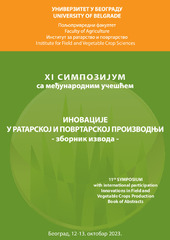Приказ основних података о документу
Biofortification: an agrotechnical measure in the production of functional food
| dc.creator | Vuković, Sandra | |
| dc.creator | Kostić, Aleksandar Ž. | |
| dc.creator | Vujošević, Ana | |
| dc.creator | Pećinar, Ilinka | |
| dc.creator | Kilibarda, Sofija | |
| dc.creator | Moravčević, Đorđe | |
| dc.date.accessioned | 2024-01-31T13:42:37Z | |
| dc.date.available | 2024-01-31T13:42:37Z | |
| dc.date.issued | 2023 | |
| dc.identifier.isbn | 978-86-7834-422-0 | |
| dc.identifier.uri | http://aspace.agrif.bg.ac.rs/handle/123456789/6837 | |
| dc.description.abstract | Fortification - the process of enriching products with essential nutrients has been used for many years in various branches of the food industry. However, the term biofortification is more recent and refers to increasing the concentration of essential nutrients, especially vitamins and microelements, in edible plant parts. The idea of biofortification as a measure in agricultural production was developed with the aim of reducing the consequences of “hidden hunger”, which is particularly pronounced in underdeveloped countries, and refers to insufficient intake of essential nutrients. Current research shows that more than two billion people in the world are affected by a deficiency of microelements, particularly zinc (Zn), iron (Fe), selenium (Se) and vitamin A. In the context of biofortification, there are several methods that can be used to improve the nutritional value of plant products, namely: transgenic breeding methods (genetically modified crops), conventional breeding methods (selection and crossing) and agrobiofortification (application of fertilizers containing microelements). Agrobiofortification can be done in several ways: soil or foliar application of fertilizers or by treating seed before sowing. Agrobiofortification is considered as an efficient, economically justified and simple method that can be applied to all crops with known cultivation technology, with the aim of obtaining functional food. The specificity of agrobiofortification is reflected in the knowledge of the affinity of the plant species for the adoption of certain elements, in order to implement mineral nutrition in a way that ensures optimal growth and development of plants with the simultaneous accumulation of necessary elements in the edible plant parts. In addition, it is necessary to determine the optimal dose of fertilizer that is ecologically and economically justified, as well as the optimal timing of fertilizer application, that is, to determine the phase of plant development when the uptake of plant nutrients is greatest. | sr |
| dc.language.iso | sr | sr |
| dc.language.iso | en | sr |
| dc.publisher | University of Belgrade, Faculty of Agriculture, Serbia | sr |
| dc.rights | openAccess | sr |
| dc.rights.uri | https://creativecommons.org/licenses/by/4.0/ | |
| dc.source | 11th SYMPOSIUM with international Participation Innovations in Crop and Vegetable Production | sr |
| dc.subject | agrobiofortification | sr |
| dc.subject | biofortification | sr |
| dc.subject | microelements | sr |
| dc.title | Biofortification: an agrotechnical measure in the production of functional food | sr |
| dc.type | conferenceObject | sr |
| dc.rights.license | BY | sr |
| dc.citation.epage | 87 | |
| dc.citation.spage | 87 | |
| dc.identifier.fulltext | http://aspace.agrif.bg.ac.rs/bitstream/id/26091/bitstream_26091.pdf | |
| dc.identifier.rcub | https://hdl.handle.net/21.15107/rcub_agrospace_6837 | |
| dc.type.version | publishedVersion | sr |


